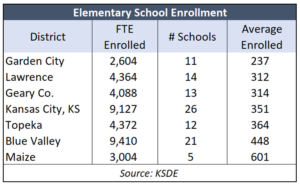USD 497 Lawrence school officials told KMBC-TV that they have a budget deficit because state funding has not kept up with inflation and enrollment has declined by nearly 900 students since 2015. But like many funding claims from education officials, this one isn’t true.
 Not counting KPERS pension funding, state aid per student for the Lawrence district was $6,431 in 2015 and is budgeted at $7,750 this year – that is a 20.5% increase.[i] The Consumer Price Index for Midwest cities was 9% on a fiscal year basis through last year and is trending to finish this year at 16.6%.
Not counting KPERS pension funding, state aid per student for the Lawrence district was $6,431 in 2015 and is budgeted at $7,750 this year – that is a 20.5% increase.[i] The Consumer Price Index for Midwest cities was 9% on a fiscal year basis through last year and is trending to finish this year at 16.6%.
The district’s budget deficit is largely due to the enrollment decline because funding is based on full-time equivalent enrollment. USD 497 lost more than 800 students as a result of how the district handled the COVID situation, and most of them haven’t returned.
Inflation is hurting everyone, not just schools, and the blame for that goes to the Biden administration’s outrageous deficit spending, not legislators. Instead of trying to pass the blame, Lawrence officials need to own their spending problems and implement solutions.
 The Lawrence Journal-World reports that district officials considered, but for now passed on closing some elementary schools that only have about 200 students each. Parents and staff understandably don’t want to close schools, but at some point, spending extra to keep some buildings open diverts resources away from educating each student in the district.
The Lawrence Journal-World reports that district officials considered, but for now passed on closing some elementary schools that only have about 200 students each. Parents and staff understandably don’t want to close schools, but at some point, spending extra to keep some buildings open diverts resources away from educating each student in the district.
Lawrence has low average enrollment per elementary school (312 students) compared to districts with total enrollment closest to theirs. Among those with the next three highest and lowest total enrollment, only one – Garden City – is lower with average enrollment of 237 students. The Maize district in Sedgwick County averages more than 600 students per elementary school.
Accomplishments and Challenges
The Accomplishments and Challenges section of the Lawrence school budget offers insight on some other cost-saving opportunities by reprioritizing some resources to what should be the district’s #1 priority – improving academic performance for all students and closing achievement gaps.
Lawrence list 14 challenges in its budget book. Improving academic performance and closing achievement gaps is #3 and none of the others speak about student achievement. There are five challenges related to funding (they want more); other non-instruction challenges include
- The judicial selection process
- moving school board elections to spring
- eliminating a legislative policy goal calling for districts to allocate more money to Instruction
- ensuring that commercial properties are appraised at their highest and best use
- using “meaningful and reliable assessment systems to evaluate academic growth”
One might argue that the district’s opposition to the policy goal for instruction spending is a legitimate education issue, but it is nonetheless perverse for a district to be arguing against allocating more money to instruction.
The board and district officials are mostly focused on money and politics, not academics. In fact, their challenge of ‘meaningful and reliable assessment systems’ is about diminishing accountability for academic improvement. The state assessment itself is fine even if the ever-changing standards and definitions are problematic; the problem is that parents are finally understanding that the results are horrible.
The district doesn’t want parents to know, for example, that 42% of their high school students are below grade level in math and only a quarter are on track for college and career.
The Accomplishments section makes no mention of general academic improvement but is heavily focused on diversity, equity, having ‘culturally sustainable resource criteria’ and ‘culturally relevant teaching.’ Honest discussions of diversity and history are healthy, but for generations that was accomplished without diverting resources to staff, expensive consultants, and materials.
Right-sizing non-instructional staff is another good opportunity. Lawrence has fewer students than in 2014, but the district has ten more managers. Almost all of the increase is in the category of Other Directors.
Other cost-saving opportunities
Former Indiana Governor Mitch Daniels explains how school districts, like all other government entities, have many opportunities to save money.
“This place was not built to be efficient. [But] you’re not going to find many places where you just take a cleaver and hack off a big piece of fat. Just like a cow, it’s marbled through the whole enterprise.”
Daniels practices what he preaches. He made this statement about Purdue University, where as President he has held tuition flat for ten consecutive years by examining the entire enterprise.
Lawrence school officials can close their budget gap by examining the entire enterprise and prioritizing resources to what should be their #1 priority – improving student achievement and closing achievement gaps.
_______
[i] KPERS pension funding is excluded for this purpose because it jumped 100% over the period.





